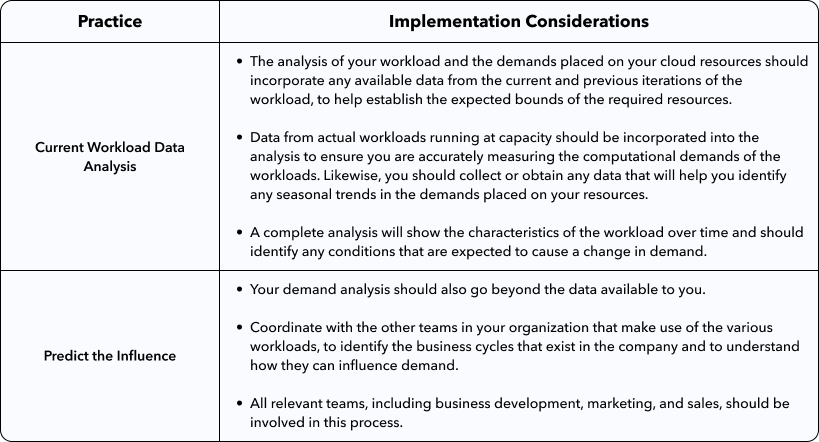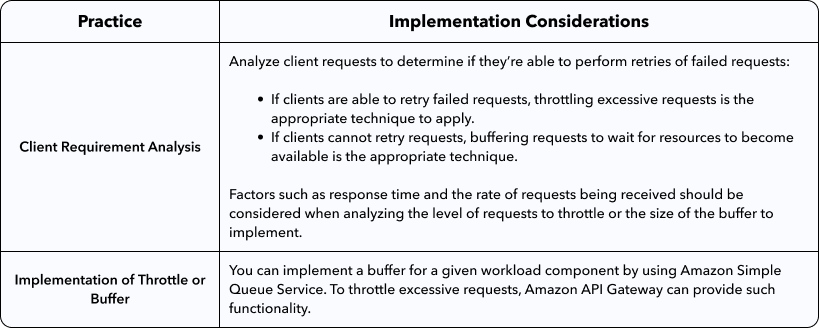This is post 4 of 5 of the Cloud Financial Management in AWS series by guest contributor Vikash Kumar. If this is your first encounter with this series, you may want to check out the first post in the series, “Best Practices for Cloud Financial Management in AWS”, before this one!
The cloud costs for a company vary with the resources required to deploy their applications and the demands placed on those services. However, by using some demand management practices, an increase in demand for resources doesn’t always need to incur increased costs.
To better manage the demand on your resources, techniques like buffering, throttling, and queuing can be used to smooth sharp increases in demand into something compatible with your deployed resources. When using demand modification techniques to balance the traffic to your services, you can help ensure that the available resources meet the demands while maintaining the organization’s goals for high availability and reliability.
Of course, managing these resources introduces overhead of its own, so it’s recommended that you plan ahead for the demand your service might experience and automate the adjustments to the supply as much as possible. In this post, we’ll cover some of the techniques your organization can employ to manage the supply and demand of cloud resources more efficiently.
Analyze Workload Demands
Before you can manage your demand, you must understand the demand. To be able to effectively manage the supply of resources and how they’re allocated to meet demands, it’s important to analyze the demand each workflow places on resources over time. Any analysis of the demand on your resources should look for seasonal trends, identify the baseline level of demand, and explain the potential benefits of using demand modification techniques.
Implementing this Practice
When performing your analysis of the demands placed on your cloud workloads, the following considerations are important to keep in mind:

Implement Throttling and Buffering for Demand Management
One of the most effective ways to manage the resource demands of your cloud workloads is to implement buffering or throttling of the workload input, allowing your systems to better handle spikes in demand. These demand modification techniques influence the demand on a given workload to help prevent peak loads from negatively impacting other resources.
Buffering and throttling serve distinct, but complementary, purposes. Throttling is the technique to apply when clients may attempt to place a level of demand on a service larger than the available resources can accommodate. When implementing a throttle on excessive requests, ensure that the client receives a timely response indicating that their activity has been throttled. In contrast, buffering allows a service to accommodate a highly variable level of demand by temporarily storing requests until resources are available to process them.
Implementing this Practice
To enable your organization to implement throttles and buffers in an effective, cost-saving manner, you should consider the following:

Allocate Resource Supply Dynamically
For any organization, it’s critical that resources are available when needed and that any future changes in demand are accounted for. To accomplish this in an efficient way, you can dynamically allocate resources based on fixed windows of time or even automatically scale the deployed resources in response to changes in demand.
While this practice isn’t as critical as the other considerations described in this post, it is still a highly effective technique for dealing with variable workloads in a cost-effective way.
Implementing this Practice
To avoid issues with dynamically-allocated resources, you should keep the following considerations in mind:

Conclusion
By scaling the level of resources deployed in your AWS environment as demands on your cloud workloads change, you can reduce wasted resources and improve the performance of your applications. As you have learned in this post, there are multiple techniques available to help you analyze and allocate resources in your cloud environment; applying these techniques in your organization can help you reduce costs and management overhead for your cloud applications.
Written by Vikash Kumar of TatvaSoft
Vikash has a rich experience in digital content publications and you will find his many by-lines published in many reputed publications.

Comments